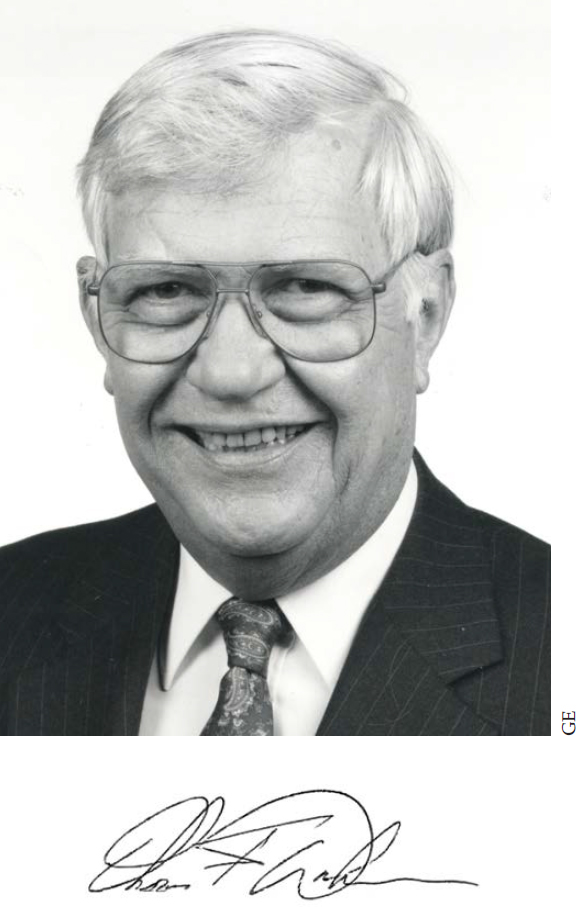THOMAS F. DONOHUE
1930–2014
Elected in 1994
“For contributions to aerothermodynamic design of advanced aerospace propulsion systems.”
BY JAN SCHILLING
THOMAS FRANCIS DONOHUE devoted his career to advances in aviation, predominantly in propulsion systems. He died October 25, 2014, in Jupiter, Florida, at the age of 84.
Tom was born August 24, 1930, in New York City. He received his bachelor’s degree in aerospace engineering from Brooklyn Polytechnic Institute in 1952 and then joined the US Army Corps of Engineers, followed by employment at Sikorsky Aircraft and the Allison Division of General Motors.
In 1961 he began work in preliminary engine design at General Electric Aircraft Engine Division in Evendale, Ohio. He supported the GE1 high-bypass ratio fan demonstrator that led to the Air Force’s awarding the contract for the first high-bypass engine, the TF39 for the propulsion system on Lockheed’s C5 transport aircraft. He played a major role in defining basic engine configuration and cycle design of the F101 low-bypass turbofan engine in support of the USAF B-1 bomber. This was followed in the 1970s by work on the YJ101 power plant that led to the F404 engine, which powers the Navy F18 aircraft. Also during this period, Tom led the CF6-6/-50 Systems Engineering team, during which the CF6-50C2A/E2A models were certified and the high-pressure compressor (HPC) titanium fire problems were resolved.
From 1981 until his retirement in 1995 Tom led GE Aircraft Engine’s Advanced Engineering Department, where he made important changes. In the early 1980s he managed the cycle definition studies on the F101X that became the F110 advanced fighter engine, powering both F16 and F15 aircraft. He later made contributions to variable cycle engine technology leading to the YF120 power plant intended to power the advanced fighter aircraft. In the 1980s when personal computers were recognized as powerful tools Tom initiated the charge to bring PCs to every engineer’s desk.
In the mid-1980s Tom was the GE technical leader for the single-stage-to-orbit National Aerospace Plane (NASP) program, including design of a subscale hypersonic flight test vehicle and sponsorship of supersonic combustion tests at Ohio State University. As a result of the NASP association with Aerojet, Tom undertook leadership of proposals for the Space Shuttle main engine turbopump turbine improvements and air turboramjet studies.
In the late 1980s and early 1990s he supported President Reagan’s Star Wars initiative with involvement in the Turbomachinery in Space proposals, which included a full-scale demonstration of a 67 MW turbine powered by superheated hydrogen driving a cryogenically cooled generator. Most significantly, he established the cycle and architecture for the GE90 high-bypass engine, which supports Boeing’s 777 aircraft, as well as technology development for the high-speed civil transport propulsion system. He drove many state-of-the-art concepts in fan and turbine aerodynamic design while supporting technology advances in materials development.
He was a member of a number of groups associated with aerospace and aeronautics: the program committee of the International Council of Aeronautical Sciences, NASA’s Congressional Aeronautics Advisory Council and Industry Advisory Board, the Aerospace Industries Association (AIA) Aerospace Technical Committee, and the SAE Aerospace Council. He also was a member of the College of Engineering Industry Advisory Council at the University of Cincinnati.
In addition to his election to the NAE, Tom was honored in 1993 with General Electric Corporation’s highest technical award, the Charles R. Steinmetz Award, for his imaginative technical contributions in the design of advanced systems leading to marketable engine products. Upon his retirement in 1995, he was inducted into GE’s Aviation Propulsion Hall of Fame. He continued to consult on aircraft engine cycles and architecture.
He had a unique blend of engineering talents that included detailed engine aerodynamics and mechanical design expertise plus an excellent working knowledge of aircraft-engine matching requirements. His leadership in pushing the technology boundaries enhanced both the commercial and military propulsion systems, thus creating a foundation that is still used today.
Tom married Barbara, his lifelong partner, in 1953. They raised three children—James, Richard, and Colleen—and enjoyed travel, history, and the arts. Throughout his life Tom did oil painting when he had time away from his passion—engineering. As he got into the full mode of retirement he took pleasure in golf and watching football. He never lost his creative side, building an N-scale railroad city. He was a strong supporter of the Arthritis Foundation.





